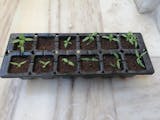


Product Description - Organic Kashmiri Chilli Seeds - Open Pollinated
The tangy and bright kashmiri chilli with its overpowering red color adds the fruity and mildly hot chilli flavor to the food. The Indian variant of Cayenne pepper is an essential in Indian, Korean and Thai cuisines. The perennial plant with its punchy flavor is a famous garnish imparting the deep red hue to soups, marinades and sauces. In addition to the attractive red color, Kashmiri chillies come with a wide range of health benefits.
Benefits/ Uses
- Like the other chilli counterparts, Kashmiri chillies are rich in Vitamin C, which is essential for skin health and proper functioning of blood vessels.
- Rich in antioxidants, adequate intake of Kashmiri chilli protects the body from oxidation by controlling free radicals, thereby averting the risk of many diseases including certain types of cancers and heart ailments.
- Rich in potassium, copper, manganese. Aids in improving bone health and metabolism. Potassium is essential to decrease blood pressure, thereby improving heart health.
- Rich in iron, kashmiri chillis improves the generation of red blood cells and augments the oxygen carrying capacity of cells
Specifications
|
Common name |
Kashmiri chilli |
|
Temperature |
18-35 degree celsius. |
|
Water |
Sufficient water to keep soil moist, not soggy. Water when top soil is dry. |
|
Sunlight |
6-8 hours of full sun. Can tolerate partial shade |
|
Soil |
Well-drained, slightly loose, enriched soil (with natural composts) |
|
Fertilizer |
Vermicompost or nitrogen rich manure |
|
Germination |
5-10 days |
|
Harvest season |
80-90 days after planting |
|
pH |
6-7 |
|
No: of seeds |
50+ |
Sowing and Caring
- To start seedling, choose a comfortable grow bag like the 24x24 HDPE bag. The seeds should be planted 0.5 inches deep and 5 inches apart from each other. If planted in rows, the gap between two rows should be at least 7-10 inches.
- Soilless medium like coco peat should be mixed with the soil to keep the air circulation intact.
- It is advised to use organically enriched potting mix like the one we have.
- Keep the soil slightly loose for the roots to breathe. 2 part gardening soil + one part vermicompost + one part cocopeat is the optimal medium.
- Requires full sun for at least 6 hours a day. Can tolerate partial shade.
- Water whenever the top soil dries out, until the soil is moist and not soggy. chillis need a lot of water to grow. Adding porridge water is seen to boost growth.
Harvest
- chillis will be ready to harvest in 80-90 days after germination.
- Carefully remove the mature yields from the plants without affecting the newly grown flowers (yet to become chilli).
Common Problems
- Caterpillars, Spider mites, nematodes, Trips, Aphids and Grasshoppers are common pests that affect the chilli crop. In addition, bacterial leaf spot is a common problem along with leaf curling.
Precautions
- Overwatering should be avoided and the soil should be well-drained to avoid fungal infection. Water only when the soil is dry 1-2 inches from the top.
- Prune the affected parts to prevent spreading of disease.
- It is advisable to add Neem oil fertilizer or pesticide like the one we have to prevent the attacks from pests and diseases.
- Vermicompost or any organic soil enrichers should be added once in 2-3 weeks to stimulate growth. Adding nitrogen-rich organic manure/ fertilizer like the one we have will stimulate faster growth.







